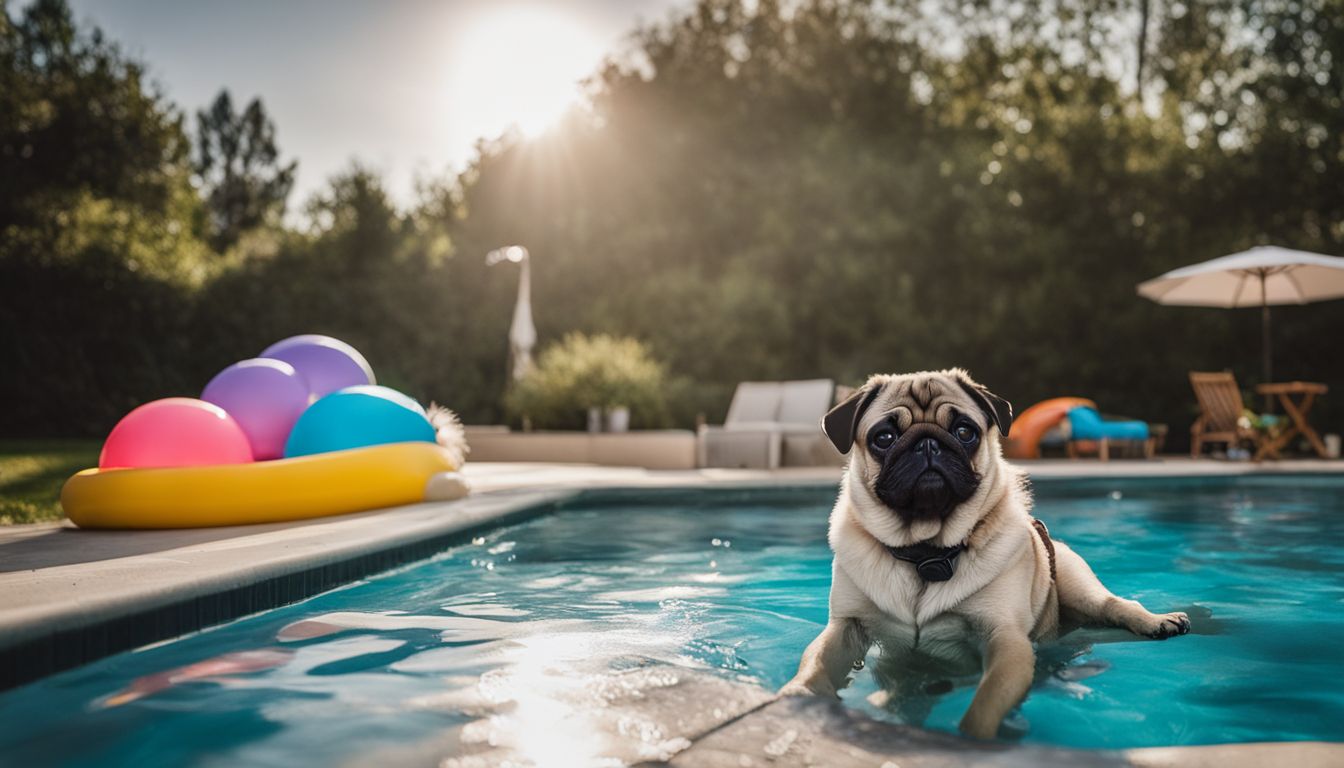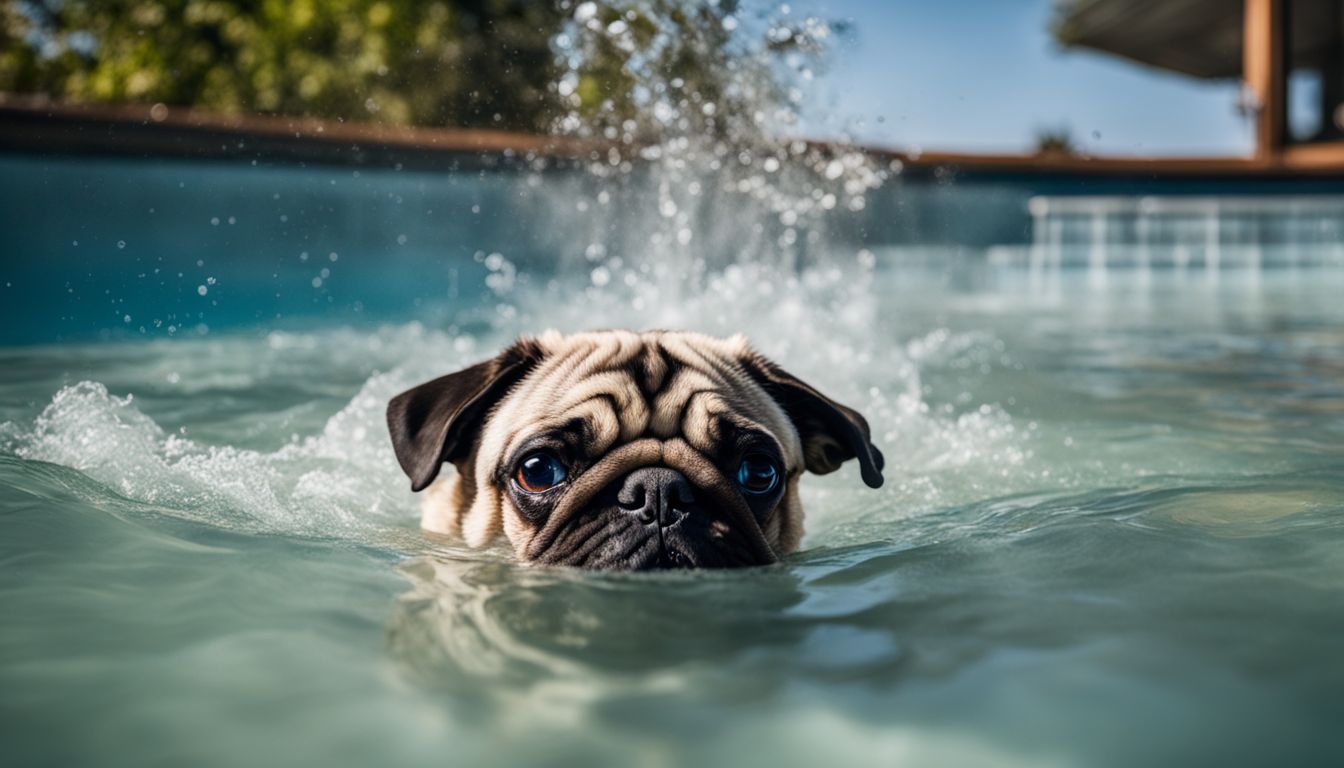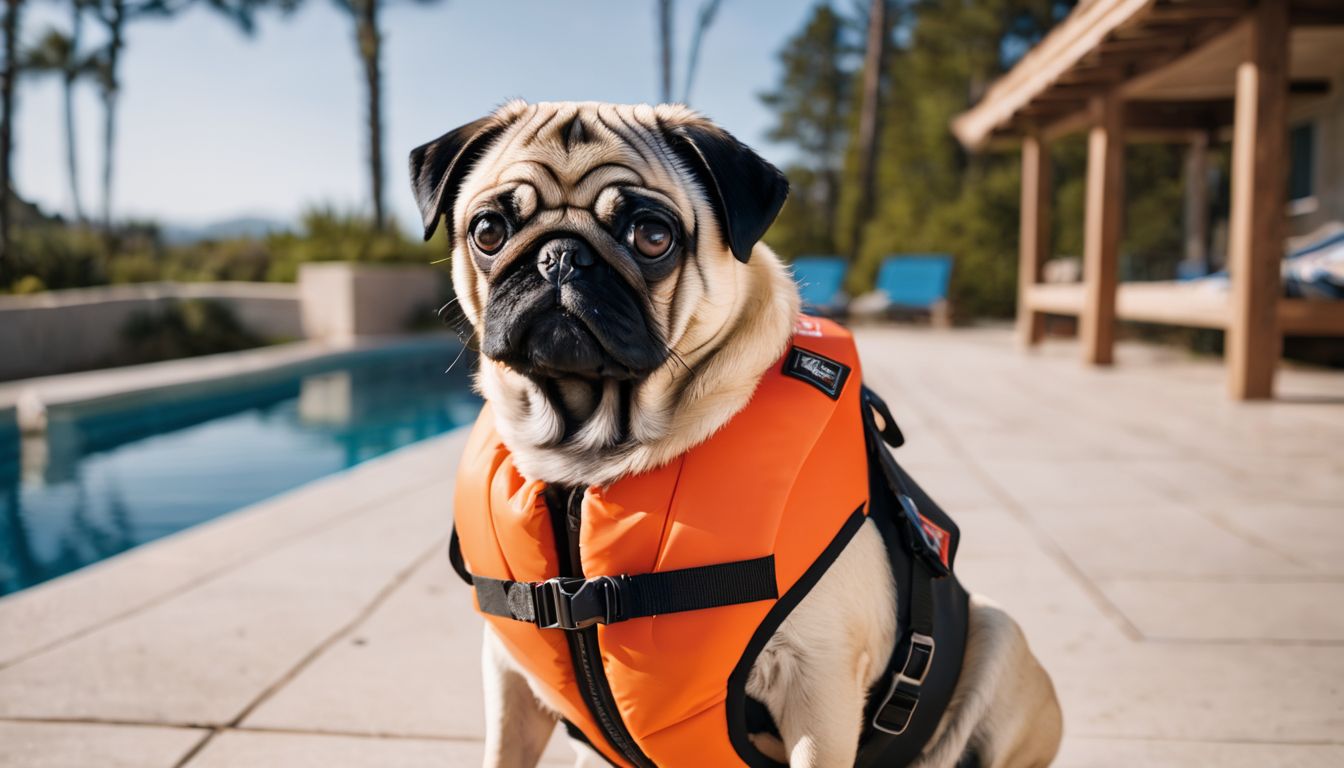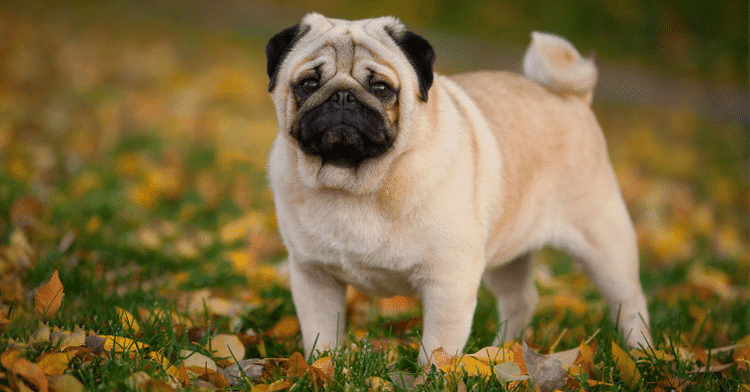Can A Pug Swim? Exploring The Aquatic Abilities Of Pugs
Have you ever caught yourself watching your lovable pug, with their squished little face, and wondered if they could join in on the summer pool fun? If you’re like many devoted pet parents of these charming flat-faced companions, curiosity about their aquatic abilities has probably crossed your mind.
Well, fret not! We’ve taken a deep dive into the subject to bring you definitive answers. Within this article, we’ll peel back the layers of myth and fact when it comes to pugs and paddle time. Can a pug swim?
Plus, we’ve got some top-notch tips up our sleeve to make sure that swim time is nothing but a blast for your four-legged buddy. So come on in—the water’s fine! Let’s jump right in and explore what lies beneath the surface for our pug pals and pools.
Key Takeaways
- Pugs have a harder time swimming due to their short snouts and flat faces causing breathing challenges, along with their compact bodies that make floating more difficult.
- For safety, it’s critical to introduce pugs to water gradually, use life jackets designed for dogs, offer treats as positive reinforcement, provide fresh drinking water to avoid dehydration, and keep swim sessions brief.
- Swimming can pose risks like respiratory distress or drowning for pugs; therefore, monitoring them closely in the water and understanding breed-specific limitations is essential.
Why Pugs Struggle with Swimming

While many dogs take to the water with ease, pugs often find swimming challenging due to their unique physical characteristics. Let’s dive into what makes paddling particularly tough for these lovable pups and how we can help them stay safe if they do venture into aquatic adventures.
Facial structure
Pugs have a unique look that we all adore, but their adorable facial structure presents challenges in the pool. Their short snouts and flat faces are distinctive traits of what’s known as brachycephalic breeds.
These features can make it tough for our pug friends to breathe easily when doing activities like swimming. We must keep a close eye on them because these same cute qualities can lead to respiratory distress if they take in too much water.
Their compact nasal passages require more effort during inhalation and exhalation, especially during strenuous activities such as swimming. This means that even though they may paddle with enthusiasm, pugs need our attentive support to ensure they stay safe while enjoying the water.
Safety always comes first; so let’s be patient and vigilant when helping our pugs take the plunge!
Body shape and proportions
Our adorable pugs carry a unique set of physical traits that, while endearing, don’t exactly make them champion swimmers. Their compact bodies and short legs require more effort to keep afloat compared to longer-limbed breeds.
Muscle strength plays a big role in swimming, but our little friends typically aren’t as muscular as many other dogs who love the water. With their squat stature and robust body shape, staying buoyant is an extra challenge for these pups.
To better understand how these proportions affect their aquatic abilities, think about how they move on land. They’re not designed for long-distance running or high-energy activities; similarly, in water, stamina can be quickly depleted with the extra drag created by their proportional differences.
It’s crucial that we adapt our expectations and take special care when introducing them to new waterscapes. Moving forward, let’s explore how reduced activity levels contribute to the challenges pugs face with swimming.
Reduced activity levels
Moving beyond their body shape and proportions, pugs often face another hurdle – their typically reduced activity levels. These affectionate dogs enjoy lounging as much as playing, which means they may not have the stamina for prolonged physical exertion like swimming.
We need to be mindful of this lower energy reserve when introducing them to water activities. It’s crucial that we don’t push our furry friends too hard; exhaustion can sneak up quickly on a pug due to their unique physical traits.
It’s also worth noting that staying fit and active overall can help your pug when it does take to the water. Regular exercise tailored to your dog’s abilities will strengthen its muscles gradually, giving it a better shot at enjoying swim sessions safely.
However, always keep an eye out for signs of tiredness or distress in the water, and be ready to scoop your buddy up for a rest. After all, safety trumps fun when it comes to our precious companions’ well-being in aquatic environments.
Risks of Pugs Trying to Swim

When we consider our adorable pugs splashing around, it’s essential to recognize that their enthusiasm may not translate into aquatic prowess. Despite their eagerness, the physical makeup of pugs presents a variety of swimming risks that can turn a fun day at the pool into a challenging ordeal for both the pooch and the pooch parent.
Breathing difficulties
Pugs often face breathing difficulties when trying to swim due to their brachycephalic facial structure. With flat faces and short snouts, our little buddies’ airways are not as efficient as longer-nosed breeds.
They can quickly become out of breath or inhale water, which puts them at risk of drowning or developing other respiratory issues. Vigilance is key while they’re in the water; if we notice any signs of struggle or discomfort, it’s time to scoop them up for a break.
Fatigue and muscle strain present another challenge for pug swimmers. The next section will dive into why these small but mighty dogs may tire more easily in the pool and what we can do to help keep their muscles healthy and happy during their aquatic adventures.
Fatigue and muscle strain
As we tackle the challenges pugs face in water, it’s clear that fatigue and muscle strain can quickly become a problem. These little dogs have less stamina compared to other breeds, so when they swim, their muscles work overtime.
The extra effort needed to stay afloat and propel themselves through the water can tire them out fast. This exhaustion isn’t just uncomfortable for our furry friends; it could be dangerous.
We need to watch for signs of weariness like slower movements or heavy panting. Just because they’re paddling doesn’t mean they’re not pushing their limits. Our role as vigilant owners is crucial here — we must ensure they don’t overdo it and risk injury or worse.
Using a life jacket helps reduce this strain by supporting some of their weight and giving us peace of mind knowing our pug has that extra help staying buoyant in the pool or any body of water.
Hypothermia
Hypothermia is a real risk for our pugs when they’re exposed to water, especially if the temperature drops. Their body shape and size make it hard for them to regulate body temperature effectively.
If a Pug’s core temperature falls too low while swimming, hypothermia can set in quickly. We must always check the water and air temperatures before letting our furry friends take the plunge.
We keep an eye on their behavior as well because signs of shivering or sluggishness signal that it’s time to warm up immediately. Dry them off with towels right away and provide a cozy blanket if needed.
It’s also smart to have a warm space ready where they can recover after any swim session. Now let’s move on to how we can safely teach our pugs to enjoy the water without undue stress or danger.
Teaching Pugs to Swim
Despite their inherent physical limitations, with patience and the right approach, it’s possible to introduce your pug to the joys of swimming – join us as we dive into how this can be safely accomplished.
Using a life jacket
Outfitting your Pug with a life jacket is like giving them a safety net in the water. Life jackets provide buoyancy, making it easier for them to stay afloat and reducing the strain on their little bodies.
We always ensure that the life jacket fits snugly without restricting breathing or movement. It’s especially important because of our Pugs’ unique body shape and proportions, as well as their brachycephalic facial structure which can impact their natural ability to swim.
We gently place the life jacket on our Pugs before getting into the water, letting them get used to its feel. This way, they become comfortable moving around with it on land first.
The handle on top of most life jackets is really helpful; if our furry friends need quick support or rescuing, we can easily lift them out of the water. Plus, they often come in bright colors which make it simple to keep an eye on our swimming companions amidst splashes and waves.
Introducing them to water slowly
Now that your pug is geared up with a life jacket, it’s crucial to ease them into the aquatic environment gently. Begin by letting them get their paws wet in a calm and shallow area where they feel secure.
Encourage them with soothing words and gentle guidance; this helps build confidence around water. Gradually increase their exposure, always observing how they react to ensure they’re comfortable and not overwhelmed.
Keep every encounter with water positive. If your pug seems hesitant or anxious, take a step back and provide plenty of praise for any small accomplishment they make. Remember, each pug will have its own pace when learning to swim; some may splash joyfully right away while others need more time to adjust.
By patiently introducing them to the joys of swimming at their own speed, you’ll help foster a love for water in no time.
Starting in shallow water
Let’s make sure our pugs’ first swim is a positive experience by starting in shallow water. We can find a quiet, calm spot where the water barely covers their legs. This way, they get used to the sensation of water without feeling overwhelmed.
Gently encourage them to walk around and explore, using treats as motivation if necessary.
We stay close to our furry friends, offering support and praise as they paddle in this new environment. It’s crucial for us to be patient; some pugs may splash right in while others take more time to warm up to the idea of swimming.
As long as we’re there to guide them through every small step or paddle, they’ll start building confidence in no time!
Swimming with your Pug
Swimming with your pug can be a delightful bonding experience if done right. We put on their life jackets and gently guide them into the water, ensuring their comfort at every step.
Their short snouts make breathing a bit harder, so we stay attentive and supportive while they paddle around. Our presence gives them confidence and lets them know it’s okay to splash and have fun in the safety of our care.
We always keep our swimming sessions joyful but brief. Pugs aren’t built for long-distance swims, so we watch for any signs of fatigue or distress. It’s all about positive experiences: quick dips in the kiddie pool under the sun can mean a world of adventure for these little companions while safeguarding their health—and we wouldn’t trade those moments for anything!
Safety Precautions for Pugs and Water
Ensuring the safety of your Pug around water is paramount. Here, we offer strategies to protect your furry friend from the hidden dangers that swimming can pose.
Bringing a friend
Safety comes first when introducing your pug to the water, and having a buddy by your side can make all the difference. Make sure you’re not alone in case your little swimmer needs help.
Friends can take turns keeping an eye on your dog, making the swimming session safer and more fun for everyone. It’s especially important given that pugs are brachycephalic dogs, which means they could face unexpected difficulties while swimming.
Bring along someone who knows how to handle dogs in water or even another pooch who is confident in the pool. Watching a doggy pal paddle with ease might inspire confidence in your pug.
You’ll be there to cheer on each other’s pets, assist if any challenges arise, and ensure everyone stays happy and secure throughout the aquatic adventure.
Using treats
Just as you’d enjoy a snack after some exercise, your pug will love a tasty treat to associate with swimming fun. Encourage your furry friend by rewarding their brave splashes with small, delicious rewards.
Keep the treats light and easy to digest, especially when they’re taking breaks from paddling around. This way, you’ll reinforce positive feelings towards water activities and motivate them to keep trying.
Use the magic of these little incentives to make each swim session something your pug looks forward to rather than dreads.
Make sure that the treats are safe for your pug’s unique dietary needs—avoid anything that might cause gastroenteritis or react poorly with chlorine if swimming in a pool. The right treat at the right time can work wonders for building confidence in the water.
Plus, it strengthens the bond between us and our pugs during this new aquatic adventure!
Providing drinking water
Encouraging your pug with treats can work wonders in making them comfortable in the water, and as they paddle and play, staying hydrated is key. Make sure fresh drinking water is readily available during swimming sessions.
Pugs exert a lot of energy while trying to keep afloat and cool off, so they’ll need to drink more than usual. Heat exhaustion isn’t just about temperature; it’s also about dehydration.
Have a bowl filled with clean water at the edge of the pool or on the shore if you’re by a lake. It will help prevent your furry friend from gulping down chlorinated pool water or salty sea water, which could upset their stomachs.
Instead, they’ll lap up safe and refreshing drinking water whenever they take breaks from their aquatic adventures. Keeping your pug well-hydrated supports their overall health and keeps those tails wagging even after swim time is over.
Keeping sessions short
We’ve learned that pugs can swim, but they may tire quickly due to their unique physical characteristics. Keeping swimming sessions short is key to ensuring your Pug’s safety and enjoyment in the water.
Begin with brief dips and gradually increase time as your furry friend becomes more comfortable and confident. This approach helps prevent exhaustion and keeps swimming a fun, stress-free activity for both of you.
Monitor your Pug closely during water playtime. Their brachycephalic features mean they can overheat or struggle to breathe if sessions drag on too long. Short, frequent swims are much safer than a single prolonged session, especially on warmer days.
It allows them rest periods where they can catch their breath and rehydrate before diving back into the fun!
Understanding your Pug’s breed
As we shift our focus to the traits of this lovable breed, it’s essential to acknowledge that Pugs have distinct characteristics which influence their swimming abilities. Their brachycephalic structure presents challenges as their short snouts don’t allow for easy breathing, especially during strenuous activities like swimming.
Recognizing these limitations means knowing your Pug’s physical strengths and weaknesses before introducing them to water.
Additionally, each Pug has its own personality and comfort level when faced with new experiences. While all pugs possess an instinctual ability to swim, not every one of them may take pleasure in it.
It’s vital to observe your furry friend’s reactions near water and respect their individual preferences. Ensuring a positive introduction to swimming depends on being patient and understanding the unique requirements associated with your Pug’s breed.
Can a Pug Swim Conclusion
In closing, diving into the world of pugs and their relationship with water reveals a mix of caution and adventure. Every Pug has its own unique swimming journey, influenced by physical traits and personal preferences.
We bear the responsibility to keep them safe while they paddle. With patience and the right approach, we might just be surprised at what these charming dogs can do in the water. Let’s make every splash count for our flat-faced friends!
FAQs
1. Can pugs swim naturally?
Pugs can swim, but they aren’t natural swimmers like some other dog breeds. Since pugs have a compact body and short snout, swimming may be more challenging for them.
2. Should I teach my pug to swim?
Yes, you can teach your pug to swim carefully. Always introduce your pet slowly to the water and use floatation devices to help ensure their safety.
3. Is it safe for all pugs to swim?
While many pugs can learn to enjoy the water, some may struggle due to health issues or physical build. It’s important always to supervise your pet closely when in or near water.
4. What are the best practices if I want my pug to swim?
Start by getting a life vest tailored for small breeds like pugs and choose calm waters for their first swimming lessons. Praise them often so they associate swimming with positive experiences!







